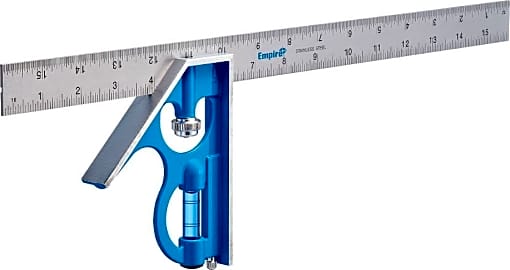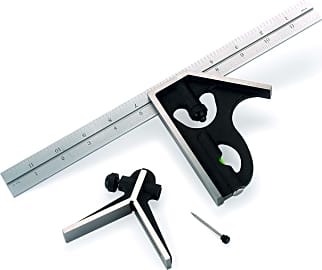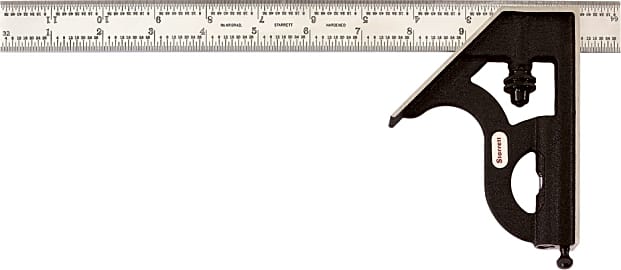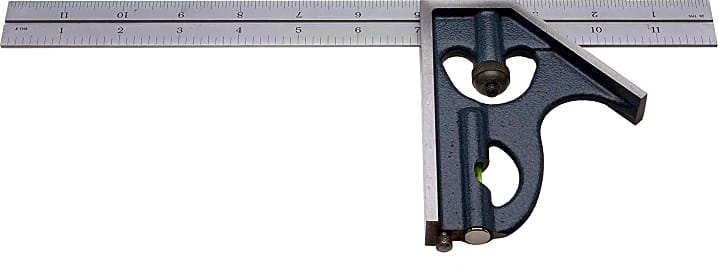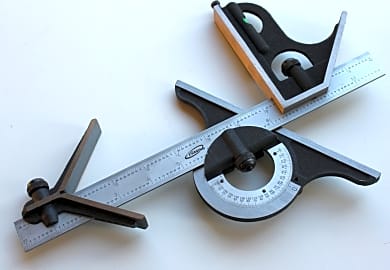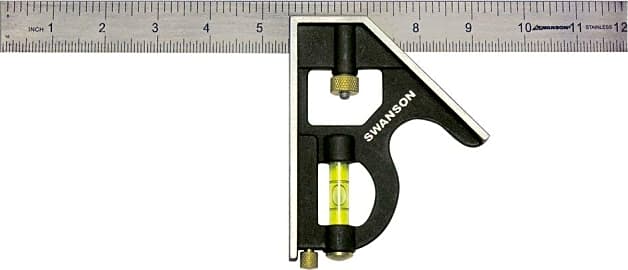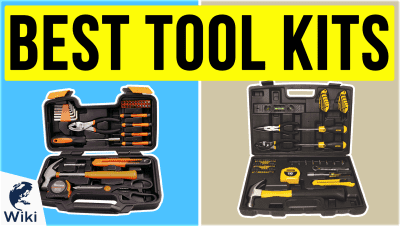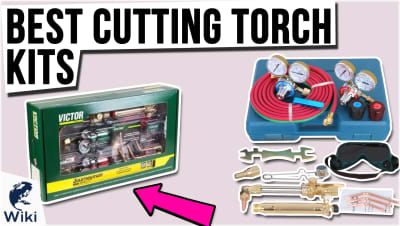The 10 Best Combination Squares

This wiki has been updated 35 times since it was first published in April of 2016. As the old adage goes, "Measure twice, cut once," and these combination squares will allow you to do just that. The models included here offer precise distances down to fractions of an inch, angle-laying functions, as well as the ability to determine flatness. They are ideal for getting the perfect fit on any job, and should be a staple in any contractor's or handyperson's toolbox. When users buy our independently chosen editorial recommendations, we may earn commissions to help fund the Wiki.
Editor's Notes
August 06, 2021:
Not much has changed with these classic measuring devices, and nothing's changed recently in our recommendations. The Starrett C33H-6-4R remains the clear winner because, like everything from Starrett, it's made with care and precision and can last a lifetime with proper care. The Starrett 11H-12-4R is a touch more affordable, but if you want something really economical and can live without absolute pinpoint accuracy, the Empire E280 is still a great choice.
January 30, 2020:
Removed the Kapro 325M and the Irwin Tools 1794469 in favor of the Pinnacle 149872 and the Johnson Tool 420EM-S. The concern with the Irwin is that its locking mechanism is not guided accurately enough to produce reliable 90 and 45 degree angles with the face when tightened. The concern with the Kapro is that, while the concept of using magnetic locks for the blade is novel and interesting, practically speaking, it prevents it from being used in all of the ways that a combo square is normally used - specifically, the magnetic locks are not strong enough to hold the blade in place when scribing perpendicularly to the blade and this also makes it frustrating when gauging depth as you would when creating mortises.
The Starrett C33H-6-4R is a beautifully crafted tool whose squareness will never be in question. If you have the money, by all means, you should invest in it. However, I've had great success using the very affordable Empire E280, and particularly with its 6-inch counterpart (E255). They are perfectly square, which is perhaps the most important feature that a combination square should have. When a combo square is not perfectly square, even small deviations are ultimately greatly compounded when producing complex structures (since subsequent cuts will also deviate from 90 and together they will result in greater deviations).
A Long History, By Any Measure
Recently adapted manufacturing processes allowed countless innovators to bring their ideas to market, helping to further American prosperity overall.
Largely unchanged for generations, hand tools were revitalized in the 19th century thanks to cheap, plentiful coal power and newly refined steel alloys. Recently adapted manufacturing processes allowed countless innovators to bring their ideas to market, helping to further American prosperity overall. In fact, many successful, modern-day tool companies can trace their roots to the latter part of the Industrial Revolution, and in some cases directly to a single product that first made the company relevant. When Laroy S. Starrett invented the combination square in 1879, he paved the way for his namesake corporation to grab hold of not only historical record, but also decades of market share.
Of course, Mr. Starrett was far from the first to develop a precise measuring tool; he simply refined and marketed it. The reality is that the very concepts of societal growth that inspired Starrett's generational invention — rapid population growth, technological advancement, and large-scale or even global commerce — were the same forces that had always inspired people to develop consistent, reliable systems of measurement.
No One's Feet Are That Big
Throughout history, society itself has been the driving force for the adoption of defined measurement systems. The introduction of agriculture, a tool absolutely necessary to support growing populations several millennia ago, called for reliable and consistent quantities, lengths, and durations. In early civilization, isolated regions and villages often upheld their own standard systems, but as imperialism and ultimately globalism began to shape Europe, cross-societal norms were established.
Some claim that the revolutionary United States wanted so badly to differentiate itself from Britain that it avoided even their measurement units and devised its own.
It's at least a little ironic that Starrett designed and released in the USA what would become a world-renowned tool, as the US is one of three total countries that use the Customary System of units. Some claim that the revolutionary United States wanted so badly to differentiate itself from Britain that it avoided even their measurement units and devised its own. In actuality, Ben Franklin himself spent the late 1700s collaborating with European officials to design the metric system, while Thomas Jefferson handed Congress a proposal for a base-10 system of feet, inches, and miles that looked suspiciously like today's centimeters, meters, and kilometers.
Regardless of the initial motivation, however, the USA was the first major body to enact official policy regarding the adoption of a measurement system, and the Customary System gained a foothold in history. Even though the metric system was a straightforward, base-10 system of interrelated units, all of which had distinct definitions, the fact is that a single, major economic power wanted its own standardized system. What does that mean to builders today? Make sure your combination square has both of them.
A Right Angle Is An Interesting Thing
Geometry and biology buffs will agree that there is no such thing as a right angle in nature. Technically speaking, that's true; actually, technically speaking, a perfect right angle doesn't exist anywhere, thanks to two particular, separate types of uncertainty (of the quantum and Heisenberg varieties). All pedantry aside, approximate right angles are the bread and butter of craftsmanship, whether building a birdhouse or a family home.
The simplest combination squares consist of two pieces. The rule is the tool's shaft, marked at certain intervals on one or both edges of one or both sides, and usually featuring a central groove to accommodate the head. This second half of the instrument is generally two-sided, with one ninety- and one forty-five-degree head. Also present on most basic models is a simple spirit level and a thumbscrew for locking in measurements.
The advantages of a combination square over a ruler or tape measure lie in its consistency, accuracy, and precision.
The advantages of a combination square over a ruler or tape measure lie in its consistency, accuracy, and precision. Accuracy is an instrument's ability to take readings that are close to the actual value, while precision involves returning the same or similar values for multiple readings in a row, regardless of whether those values are actually correct or not. The square's rigid body and locking stop, therefore, provide it with much of its usefulness; once you've made a mark, you can be certain that the rest of the marks you make share the same measurements.
These advanced straight-edges have even more to offer than simple lines, though. Additional heads like protractors and 45-degree holders help with important tasks like individual angle measurement and replication, as well as quickly finding the center lines of a circle. Most squares are crafted of stainless-steel alloy and are relatively resistant to corrosion. You certainly don't have to spend much on one, either, especially if you'll use it only sparingly; anyone who checks or marks angles on a full-time basis, however, will quickly notice the benefit of a professional-quality model. A smooth-sliding, close-tolerance, tempered-steel model is a good choice for career carpenters or seriously dedicated DIYers.
As with many simple tools, squares are available from well-known, long-lived manufacturers, as well as never-before-seen internet resellers. And also, like many other implements, it can pay off to choose a more respected brand, even if it's little more costly. Pay attention to recent reviews of the company's products, and take special note of their warranty policy; most companies that make quality hand tools will stand by them for a long, long time, sometimes even for life. And though the specific manufacturer is also important, the continent where the product is produced doesn't necessarily tell us anything. Countless high-quality products are assembled in China, while there are plenty of American manufacturers cutting corners. The important part is whether or not they stand behind their products.
At the end of the day, you can spend just a bit more on a combination square, or a lot more. The higher quality a brand is, the more likely it will offer a comprehensive line of alternate heads and other accessories. And there's little as frustrating as a cheap knock-off product slipping, chipping, or flat-out breaking. But what's even more important than the tool is a steady hand, and plenty of practice.


